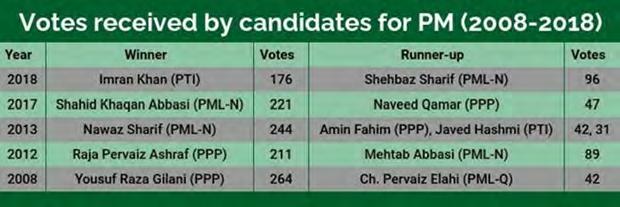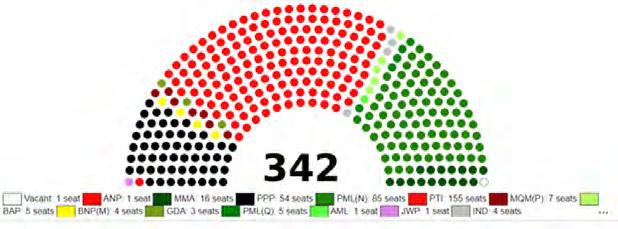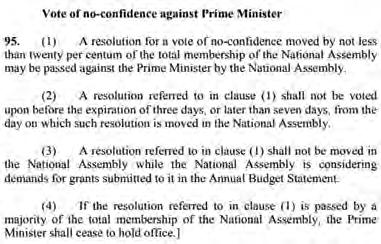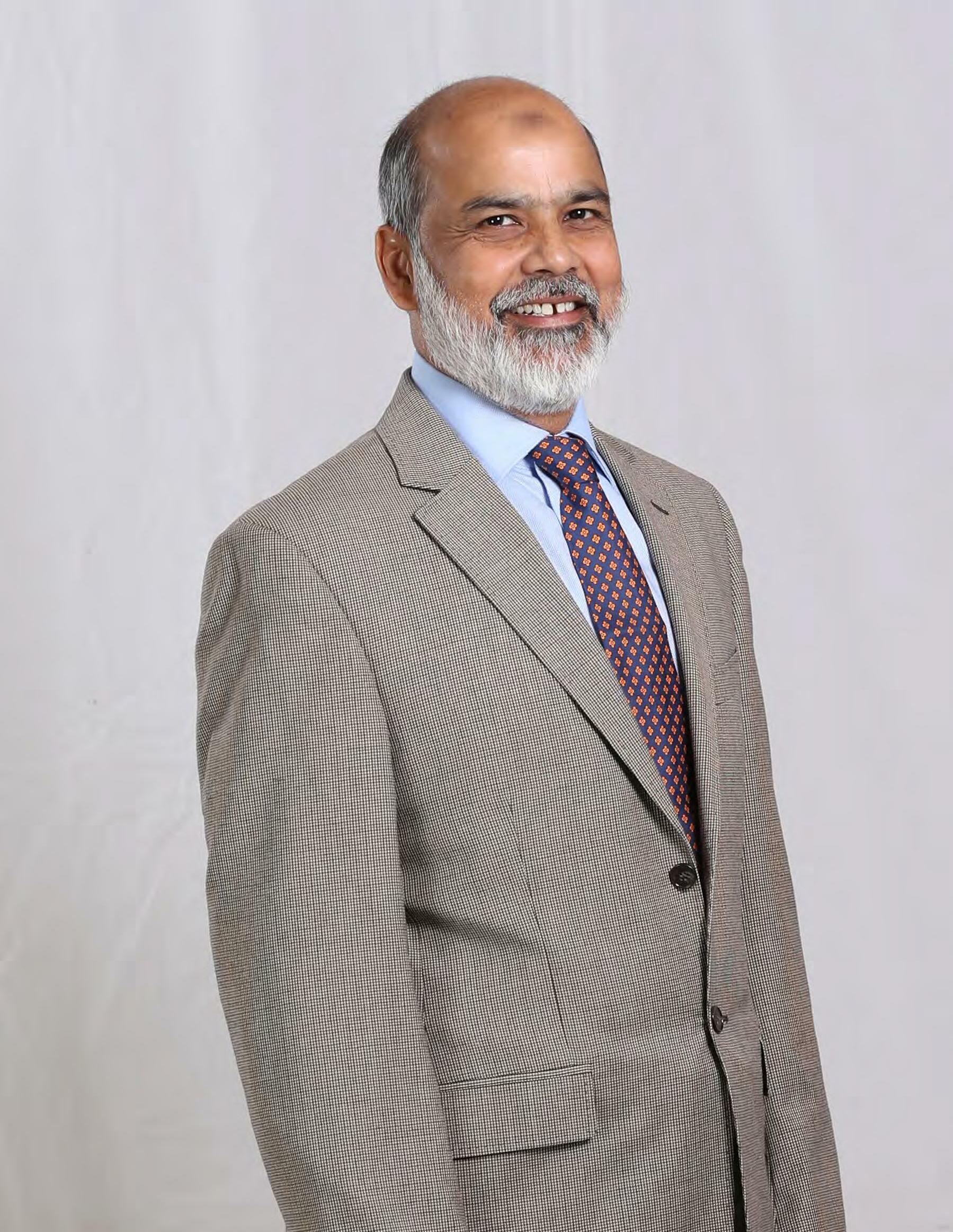
7 minute read
No-confidence - how we got here what are the technicalities, and what will happen next 26
No-confidence
how we got here, what are the technicalities, and what will happen next
Advertisement
By Abdullah Niazi
The past 90 days have proven to be a political minefield in Pakistan, with the heat being turned up on Prime Minister Imran Khan as he faces a very strong attempt to dislodge him from power through a vote of no-confidence. As the Prime Minister navigates the choppy waters, the electorate has also faced a barrage of information regarding how such a motion works. Profit explains the timeline and technicalities about where we are today, and what is to be expected in the upcoming weeks.
The build up Feb 6th:
PPP Chairman Bilawal Bhutto Zardari along with his father former President Asif Ali Zardari meet with the top-brass of the Pakistan Muslim League Nawaz including Maryam Nawaz and Shehbaz Sharif. In the meeting, the two biggest opposition parties agreed to send Prime Minister Imran Khan packing. The easiest way to achieve this? A vote of no confidence in the National Assembly.
Feb 11th:
President of the Pakistan Democratic Movement Maulana Fazl ur Rehman announces the opposition alliance, including the PPP, have all agreed to move a no-confidence motion against the Prime Minister in the National Assembly. To win the vote, the opposition needs a simple majority, which means they need 172 out of 342 members of the lower house to vote for them. At this point, the joint opposition (PPP, PML-N, and MMA) have 155 seats in the legislature, and the PTI also has 155. From here on the game is afoot to sway the PTI’s electoral allies and legislators willing to defect.

What does the constitution say?
The opposition had to file two motions with the speaker. Since the national assembly was not in session right now, which means it was not meeting and was on a break, the opposition had to demand that a session be called. This can be done under Article 54 of the constitution, which holds that a session of the National Assembly can be requisitioned if at least 25 percent of the members sign it, following which the
speaker has a maximum of 14 days.
Once the assembly has been called in this way, the opposition can then also file a no-confidence motion. This is done in accordance with Article 96 of the constitution. According to this, for a vote of no-confidence against the prime minister, at least 20 percent of the total MNAs, which means 68 members, have to sign a resolution for it to be voted on. A notice regarding this will then be circulated among the members. After the motion is moved, there will be no voting for at least three days and the voting will take place no longer than seven days after the motion is moved.


February to March:
The next one month is spent in a political melee. Legislators loyal to estranged PTI leaders Jehangir Tareen and Aleem Khan discuss the terms on which they will support the opposition in their efforts to oust the Prime Minister - with the primary demand being the removal of Usman Buzdar as Chief Minister of Punjab. Imran Khan once again stands by Buzdar. The PML-Q, important allies of the PTI both at the center and in Punjab, also threw their hat in the ring, demanding Chaudhry Pervez Elahi be made Chief Minister instead of Buzdar. The Chauhdhrys of Gujrat suddenly have more weight than their numbers show, and both the government and the opposition engage in an attempt to woo them to their respective sides.
The assembly is called
March 8th:
A delegation of senior opposition lawmakers submitted the no-trust motion against Prime Minister Imran Khan with the National Assembly Secretariat. The assembly will be called under article 54 of the constitution, and the no-confidence motion will take place under Article 95 and 96 of the Constitution. The speaker now has to call a session of the lower house within two weeks, which means by the 22nd of March.
March 10th:
The government makes its intentions known to disqualify MNAs that plan on switching ranks and voting against the government. Interior Minister Sheikh Rasheed says the speaker has the right to disqualify members that change parties on a vote of no confidence. However, the opposition retorts by saying the disqualification can only happen after the votes have been cast and not on assumption.
March 16th:
In a surprise statement, PML-Q leader Chaudhry Parvez Elahi backed the joint opposition’s claims of having the support of more lawmakers than required to ensure the no-confidence motion against the prime minister succeeded. An ally of the ruling party, Mr Elahi also said there are “plenty of surprises in store” during an interview. Fears continue to rise among the ranks of the embattled PTI.
March 17th:
The fears continue to rise as it turns out that a large number of ruling-party MNAs are staying at the Sindh House in the capital. According to one of the dissident MNAs, there were around 24 PTI legislators that were staying at the facility controlled by the Sindh Government. The matter of disqualification for these MNAs heats up again and the government takes the matter to the Supreme Court.
March 18th:
The Prime Minister directs speaker Asad Qaiser to call a session of the National Assembly to summon the lower house session on March 21.
What are the powers of the speaker?
According to Article 63-A of the constitution, a member can be removed from office if they vote against their parliamentary party on an issue of a no-confidence vote. According to Article 63-A of the Constitution, a parliamentarian can be disqualified on grounds of defection if he “votes or abstains from voting in the House contrary to any direction issued by the parliamentary party to which he belongs, in relation to election of the prime minister or chief minister; or a vote of confidence or a vote of no-confidence; or a money bill or a Constitution (amendment) bill”.
However, the speaker does not hold the power to disqualify a member. The party head of a dissenting member writes to the ECP which then tells the speaker to notify the member. The MNA then has 30 days to appeal the decision, which can go up to the Supreme Court. The SC then hae 90 days to make a final decision.
To try and disqualify the members before the vote, the government has currently approached the Supreme Court to make a ruling on Article 63, and decide whether or not such members can be preemptively disqualified rather than only after they have cast their vote.
What happens next
If the resolution does not pass, which seems unlikely at this point, then the opposition will have egg on their face. No other consequences. If it does pass, however, then heads will roll everywhere.
Under the Constitution, the speaker had to summon a session of the Assembly within 14 days of the requisition. If the speaker allows the motion to be tabled on March 21, then the debate needs to take place after three days and before seven days. This would mean that the debate will have to take place by March 25. After three days of debate, the MPs would be allowed to vote on the motion which would mean the voting would take place on March 28.
If the resolution of the vote of no confidence would be passed by a majority of the total membership of the National Assembly, the Prime Minister shall cease to hold office, the Prime Minister as per Article 95 of the Constitution would cease to hold the office and his cabinet would also be dissolved simultaneously.
As per Article 58 of the Constitution, the Prime Minister cannot go for the dissolution of national assembly against whom a notice of a resolution for a vote of no-confidence has been given in the National Assembly but has not been voted upon or against whom such a resolution has been passed or who is continuing in office after his resignation or after the dissolution of the National Assembly.
Since the vote succeeding depends on dissident MNAs, immediately after those MNAs would be removed from their seat and by-elections would be needed. At this point, a new Prime Minister would be elected by the house of representatives and Imran Khan would continue to serve until this happens. However, as per the opposition, the new Prime Minister would serve only for a few days as the goal would be to call for fresh polls. In fact, in the initial days the PPP even offered the slot to Shehbaz Sharif who said he was not interested. n








